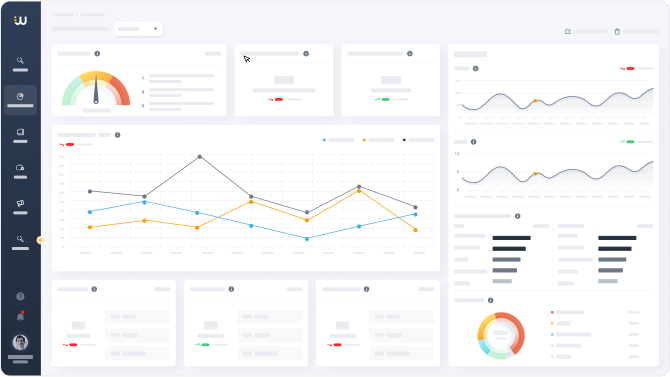Dark Web Monitoring for Business: Staying One Step Ahead of Cybercriminals

No matter your business, you’ve probably used monitoring tools for years to scan and analyze publicly accessible websites and online content for brand monitoring, competitive intelligence, SEO rankings, and customer feedback. But lurking behind the surface web has become known as the deep web–and part of the deep web known as the dark web –a whole world of activity that is hard to access, and even more challenging to monitor. Traditional tools developed for open web surveillance do not cover dark web tracking.
Since establishing the Tor Project in 2006, access to the dark web via browsers such as Tor has become more accessible; therefore, the number of users has snowballed. Currently, an average of two million users use the Tor browser daily. Although established by the U.S. government, browsers such as Tor, I2P, or Zeronet lead to a world for more than just uncensored and unmonitored internet use. The dark web is also a hub for cybercriminal activities. Whether users are selling weapons, illegal drugs, or human trafficking, it’s also a place to trade in user data and credentials, malware and phishing kits, and discussions about hacking and other security vulnerabilities.
The importance of dark web monitoring for businesses
Regarding cybersecurity for businesses, the name of the game is a proactive strategy. That’s why a cybersecurity business strategy must include dark web monitoring tools – to identify, monitor, and prevent reputational, legal, compliance, or financial damage. However, more than monitoring is required to avoid cyber security threats. In cybersecurity, being proactive means identifying vulnerabilities and anticipating threats before they strike. Dark web monitoring isn’t just about watching—it’s about staying one step ahead of cybercriminals, preventing damage from spreading, and keeping networks from being compromised.
What are the consequences of data breaches related to the dark web?
Dark web monitoring services have become essential components of cybersecurity tools for businesses. While most data breaches originate within a company’s computer systems, the results often make their way to the dark web. Cybercriminals frequently trade exposed credentials and personal identification information (PII) from compromised systems in these hidden marketplaces. The prevalence of confidential and stolen data makes dark web monitoring essential for identifying and mitigating risks before they escalate into widespread damage. This results not only in financial losses but also in reputational and legal ramifications.
Legal implications and fines
Data breaches can have severe legal implications for businesses due to various state, federal, and global laws. For example, these laws prohibit gaining unauthorized access, damaging computer systems, or spreading malware. The far-reaching implications of such breaches often attract federal scrutiny, as seen in the February 2024 Change Healthcare ransomware attack. This incident led to the Office for Civil Rights investigation, underscoring the critical nature of protecting sensitive data and the potential for wide-scale disruption when healthcare technology providers are compromised.
U.S. data breach laws require organizations to notify individuals if their personal information is compromised in a breach. Many state laws also require notifying the state attorney general or relevant agencies, adding another layer of legal responsibility for businesses. GDPR in Europe imposes even stricter penalties, with fines up to €20 million or 4% of global revenue for non-compliance.
Financial damage
Damage from dark web activities can devastate companies both financially and reputationally. The direct costs often include expenses related to ransomware payments or stolen financial data. However, the indirect costs can be just as significant—loss of customer trust, long-term brand damage, reduced customer base, and revenue loss due to operational disruptions. These hidden costs can accumulate over time, weakening a company’s market position and financial stability.
In May 2024, the Boston-headquartered Santander Bank (part of the larger Banco Santander group based in Spain) reported a breach of their database, hosted by Snowflake, a third-party provider. The breach affected 30 million customers from Spain, Chile, and Uruguay. The hacking group ShinyHunters claimed responsibility for the attack in late May 2024. ShinyHunters allegedly demanded £400,000 ($500,000) and then offered to sell the stolen data back to Santander for $2 million (£1.6 million). The bank contacted affected customers and employees directly to inform them about the breach. Although it is not apparent if Santander paid any ransom to the hackers, the bank likely incurred significant expenses for implementing measures to contain the incident, blocking compromised access, enhancing fraud prevention controls, conducting investigations, notifying affected customers and employees, and engaging with regulators and law enforcement.
The Santander breach illustrates the dark web’s role in the trafficking of stolen data. It demonstrates how cybercriminals leverage these hidden marketplaces to monetize stolen information, posing significant risks to individuals’ privacy and financial security. The incident also highlights the ongoing challenges financial institutions face in protecting sensitive data, especially when relying on third-party providers for data management and storage. Reports show that attacks disclosed by the attacker cost about 1 million dollars more than those identified by the business’s security teams and tools.
Reputational damage
According to the 2024 Telesign Trust Index, 44% of data breach victims tell friends and family not to associate with a brand that has been breached.
In May 2024, Snowflake, a leading cloud data platform, experienced a significant security breach affecting approximately 400 organizations, including major companies like Santander and Ticketmaster. The attackers primarily used credentials obtained through various infostealer malware campaigns, some dating back to 2020. They targeted Snowflake customer accounts that lacked multi-factor authentication and proper security measures. They gained unauthorized access and exfiltrated large volumes of sensitive data. This incident had severe reputational implications for Snowflake and its affected customers, including Santander. It eroded trust in Snowflake’s security practices (such as the lack of enforced multi-factor authentication). Snowflake’s reputation as a secure cloud platform was compromised when the breach affected around 400 organizations, including major companies like Ticketmaster and Santander.
Operational disruption
The Change Healthcare ransomware attack in February 2024 shows how dark web actors can cause significant operational disruptions to major American B2B companies, with far-reaching consequences across an entire industry sector. Change Healthcare, a B2B healthcare technology provider, fell victim to an extensive ransomware attack. The impact was immediate and severe, causing lasting network interruptions that inhibited the company from processing healthcare transactions. This disruption reverberated throughout the healthcare sector, preventing pharmacies from processing patient prescriptions and healthcare providers from submitting insurance claims.
The attack’s connection to the dark web became apparent when BlackCat, a notorious ransomware group known to operate in these shadowy corners of the internet, claimed responsibility. They boasted of accessing six terabytes of sensitive data related to all of Change Healthcare’s clients, underscoring the vast scope of the breach. Change Healthcare’s compromised systems affected its operations and countless healthcare providers, pharmacies, and insurance companies that relied on its services.
Benefits of dark web monitoring for businesses
Dark web monitoring services for businesses are a critical pillar of a comprehensive cybersecurity strategy. Dark web monitoring tools help companies detect emerging cyber risks early, including insider attacks, malware, phishing, exposure and trade of confidential data, and even hacktivism or cyber warfare.
With dark web monitoring services, businesses can detect early indications of attacks and prevent, investigate, and track data leaks. These services allow cybersecurity teams to act promptly and proactively to reduce risks. With the increasing frequency of cyberattacks and vulnerabilities, awareness and adoption of dark web monitoring services are expected to rise. As global cybersecurity regulations become more stringent, the demand for these services will likely grow significantly.
In 2024, global cybersecurity regulations are becoming increasingly stringent, driven by the need to address rising cyber threats and ensure better protection of sensitive data. New directives, such as the EU’s NIS2 Directive and the Cyber Resilience Act, are setting higher standards for cyber protection and mandating more transparent reporting practices in the event of breaches. These laws are designed to make businesses more accountable and to enhance overall cybersecurity resilience across various sectors.
Training employees on cybersecurity awareness
While dark web monitoring offers businesses clear benefits for cybersecurity, it’s not a silver bullet. Human carelessness and lack of cyber threat awareness is usually the weakest link in the cybersecurity chain. Even the best monitoring tools can’t stop an employee from accidentally clicking on a link in a phishing email.
Phishing emails, especially those that seem to come from someone within the company, are particularly dangerous. When businesses train employees to spot these threats, they reduce the risk of danger. Continuous employee education – including awareness of how sophisticated a threat can be – should be part of every company’s cybersecurity strategy.
Integrating dark web monitoring with other security measures
Businesses can use dark web monitoring services such as a dark web monitoring API to integrate with their inherent cyber security tools. Their teams can set up dark web tracking for categories such as threat intelligence, financial crime, cyber crime, or breach detection. Businesses can integrate dark web monitoring services with company-wide security measures such as firewalls, intrusion detection systems, or asset management systems to create a layered cybersecurity posture.
Challenges of dark web monitoring
While dark web monitoring services offer numerous benefits, they pose several challenges:
- Dark web content is hard to access and index, requiring specialized tools and expertise.
- Overlapping usernames and misleading data can trigger irrelevant alerts, demanding that a cyber analyst check the alert to differentiate genuine threats from noise.
- Dark web users and content are highly anonymous and domains frequently change names, move, or disappear, making it challenging to maintain consistent monitoring.
- Analyzing large volumes of messy, unstructured data from the dark web requires a lot of time and effort to filter out irrelevant information.
Implementing an efficient dark web monitoring strategy requires more than just automated tools—it necessitates a comprehensive process that combines Dark Web Intelligence with proactive human oversight. The first step involves the collection, where the tool gathers data from the dark web through methods like web crawling despite challenges like captchas and site restrictions. However, raw data must be structured, cleaned, and enriched to be actionable. Dark web monitoring tools like Lunar, by Webz.io, offer a platform for cyber security professionals to uncover, identify, and neutralize threats to their organizations.
Using Lunar by Webz.io, organizations can follow a clear workflow, starting with uncovering new threat actors, identifying and profiling these actors, and then taking action by monitoring for Indicators of Compromise (IOCs) to mitigate potential breaches. Combined with employee training to recognize and prevent phishing and other social engineering attacks, this approach forms a robust defense against cyber threats. By integrating and leveraging tools like Lunar, businesses can create a multi-layered security environment that detects threats and allows for rapid response and mitigation.
For a deeper understanding of how Lunar can enhance your cybersecurity strategy, we encourage you to learn how the Lunar platform can help add dark web monitoring to your enterprise.






